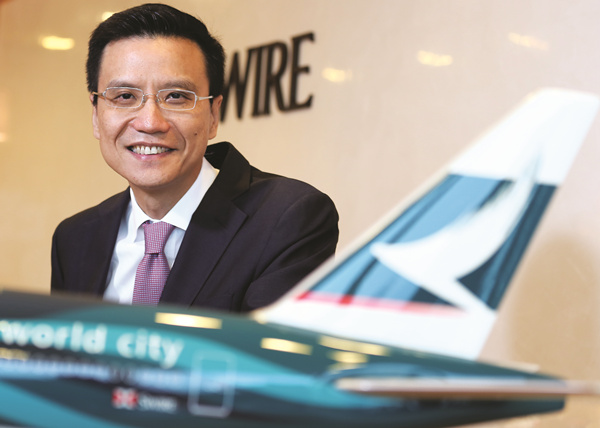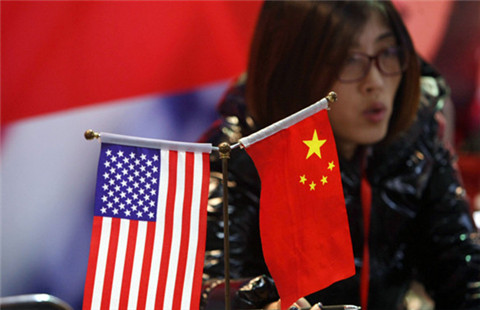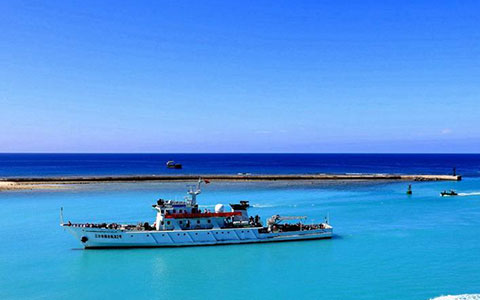Cruising altitude
Updated: 2015-09-11 23:06
(China Daily USA)
|
||||||||
 |
|
Ivan Chu Kwok-leung says Cathay Pacific is in possession of a “dream fleet” of aircraft and planning a “very balanced” flight network as it continues to add fresh long-haul destinations to its roster, which already sees it connect to nearly 200 airports worldwide. Parker Zheng / China Daily |
“We are very lucky to be in this part of the globe, where economic well-being is improving and a large number of the young generation want to see the world,” said Ivan Chu Kwok-leung, chief executive of Cathay Pacific Airways Ltd, a company founded on Sept 24, 1946.
“Normally the younger the population, and the higher the per capita GDP (gross domestic product), the more frequently people would travel. That’s what is happening on the Chinese mainland and in Hong Kong as well. Going forward, outbound tourism will continue to develop on the mainland, from which we will also continue to benefit,” Chu told China Daily in an exclusive interview.
Chu was appointed chief executive on March 14, 2014 of Cathay Pacific, the flag carrier of Hong Kong, home to the world’s third-busiest air traffic hub in terms of passenger volume.
Chu is also only the second Chinese executive, after Philip Chen Nan-lok, to get the top job in the airline owned by the Swire Pacific Ltd conglomerate.
Describing himself as “just a local kid”, 1960s-born Chu remembers the days when Hong Kong was still “very poor” — when the radio was a fancy possession and even black-and-white TV sets a luxury. Those memories are mixed with those of seeing riot police patrol Central on his way to school.
“But I was very lucky to be living at a time when Hong Kong took off,” Chu said. In 1981, three years after the launch of the reform and opening-up process on the mainland, Chu packed up and headed north, to take part in an exchange program with Nanjing University during his freshman year at the University of Hong Kong.
“It was fantastic. I made a lot of friends. I fell in love with the mainland,” Chu said. His mainland visit found Chu discovering his adventurous streak, and he spent every summer vacation thereafter exploring the country, funded by his earnings from English tutoring.
Leaving the big cities behind, Chu marched toward the furthest parts of the vast nation. For four days and three nights on the train from Shanghai to Urumchi, capital of the Xinjiang Uygur autonomous region in the northwest, he chatted with passengers in “bad mandarin”. He stayed in a Kazakh yurt, or round tent, with the locals, visited Qinghai Lake and found the place so remote and rarely traveled that even the local party secretary came to meet him.
By the time he graduated in the early ’80s, Chu had turned down offers from a world leading bank and a fast moving consumer goods company to join Cathay Pacific as one of the three managing trainees hired that year, beating out more than 1,000 applicants.
“It was hard. But fate picked me and I picked the fate,” he said. “It’s the romance of traveling that tempted me to join the airline business.”
Cathay Pacific has 202 aircraft on its current group fleet with Dragon Airlines and cargo carrier Air Hong Kong. Taken alone, Cathay has 148 aircraft.
And Chu believes the fleet is bound to grow as it endeavors to capture the opportunities arising out of swelling numbers of outbound mainland tourists.
“Geographically, Hong Kong sits in the sweetest spot at the crossroads of global air traffic,” Chu said, pointing out that all major European destinations are within 12 hours of non-stop flying from the city.
A flight path over the North Pole would make even the North American east coast, including cities like New York and Chicago, also reachable in 15.5 hours, which is roughly the maximum coverage of the latest long-haul aircraft. “As for competitors based in other Southeast Asian hubs, their airplanes can’t fly non-stop to these destinations,” Chu emphasized.
Going forward, Cathay Pacific is planning a “very balanced” network. Chu said the carrier already flies four or five times a day to major long-haul hubs such as San Francisco and Los Angeles on the US west coast, London and Melbourne. But it is keen to develop routes to destinations such as Zurich, the US northeast coast city of Boston, the Maldives and Dusseldorf. In fact, a four-times-weekly service was launched just last Tuesday to the German city, one of the nearly 200 destinations Cathay Pacific flies to around the world.
“These places are not like London, but people go there for skiing, diving, studying and business purposes. There is enough traffic to fill the (Airbus) A350, the latest long-haul plane we ordered,” Chu said.
“We have the dream fleet of any modern airline. With that what we can do is add more destinations at a higher frequency, so people can travel through Hong Kong and find it easier to connect to somewhere else. That will improve our business, as a Hong Kong-based premium hub carrier.”
However, regional skies are getting crowded and rising competition is undeniable. Carriers from the mainland have been expanding in the region as well as on cross-continental routes in recent years. And of the roughly 100 carriers that touch down in Hong Kong, a fifth are budget operators.
Having worked for Cathay also in Taiwan, Thailand and Australia, and built the sales team on the mainland, Chu told China Daily that the key strength of the airline lies in its “outports”.
“Over the years we have built a strong brand in traditional markets, like corporate and MICE (meetings, incentives, conferences, exhibitions) travel. All the way through Asia Pacific, we are in the mainstream corporate business. It will take years for mainland carriers to mimic the relationship we have built up with our clients. They are doing well in number terms, but not in terms of yield and corporate travel.”
And the ratings back up that claim. Cathay Pacific was named “World’s Best Airline” for the fourth time in the 2014 annual Skytrax World Airline Awards.
Besides, Chu added that corporate travelers also choose premium economy when they take their family on leisure trips, and that contributes to higher yields for the carrier. “We will continue to strengthen the sales team and the relationship with corporate clients,” he pledged.
- Russian military experts present in Syria
- Norway PM says Norwegian citizen taken hostage in Syria
- Hungarian TV journalist fired for tripping up fleeing migrants
- Leaders from EU, Russia, Ukraine to meet in Paris in Oct
- Music is food for the soul for young Chinese violinist
- Australia's Tasmania, China agree to 'work together' on Antarctic expeditions

 Americans mark the 14th anniversary of 9/11 attacks
Americans mark the 14th anniversary of 9/11 attacks
 7 ways Chinese travelers benefit from the US visa extension
7 ways Chinese travelers benefit from the US visa extension
 In pictures: School life from the lens of sports teacher
In pictures: School life from the lens of sports teacher
 Ten treasures from Palace Museum to look forward to
Ten treasures from Palace Museum to look forward to
 Top 10 richest Chinese tech giants
Top 10 richest Chinese tech giants
 10 years of Sino-US exhibitions
10 years of Sino-US exhibitions
 Greedy panda eats ten boxes of honey
Greedy panda eats ten boxes of honey
 Soldiers in Sansha guard the islands
Soldiers in Sansha guard the islands
Most Viewed
Editor's Picks

|

|

|

|

|

|
Today's Top News
Over 14,500 Chinese pilgrims in Mecca
Xi's trip to US to 'chart course' for ties
US to accept 10,000 Syrian refugees, says White House
WWII veterans awarded medals for victory efforts
LA still a top destination for tourists even as China's economy slows
New iPhones unveiled
Inside look at Apple's newly-launched products
Peking Opera performance thrills NY
US Weekly

|

|







